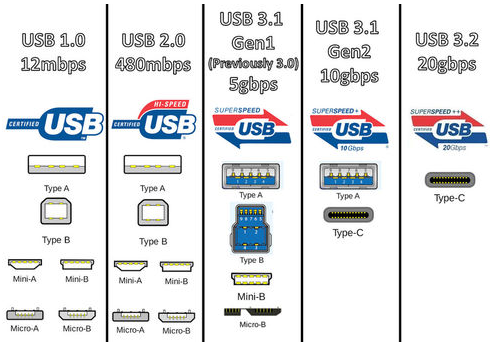Now a days, electronic manufacturers in the market continue to bring out new products every year, and they will always arouse the attention of many people when they go on the market, but they are often confused about the new specifications. When you encounter the purchase of peripheral products, you will be confuse! For example, we hear about USB 3.0 most often, and recently we heard about USB 3.1, USB 3.2, and then Gen1 and Gen2 etc…It’s confused everyone! This is not what I want! Here are some basic concepts for you, so that you can have a clearer understanding, therefore you won’t spend the wronged money!
USB 1.0:
The theoretical transmission speed is 1.5Mbps. The main purpose is to replace old computer ports and provide convenience, so the transmission speed is not the main focus! Later, due to the gradual popularity of USB, USB 1.1 appeared, and the transmission speed was greatly increased to 12Mbps at this time.
USB 2.0:
The theoretical transmission speed is 480Mbps, and the actual maximum transmission speed depends on the digital device, USB device, etc. The usage is extremely wide from Type-A to Type-B connectors are compatible, which means that early digital devices, all USB interfaces, almost all use this specification. For example: Type A for older computers, Type B for printers, Mini-A for digital translators, Mini-B and Micro-B for old mobile phones etc….
USB3.0:
The difference in appearance from USB 2.0 is that the USB 2.0 connector is white, USB 3.0 is colored (mostly blue), and is backward compatible with USB 2.0. The theoretical transmission speed has risen significantly to 5Gbps. The actual maximum transmission speed depends on digital devices and USB devices etc…, but according to some measured results, it will be approximately 3–5 times that of USB 2.0. It is also suitable for various digital devices with USB connectors, but the transmission speed is faster. For example: a newer computer Type A, external hard drive Micro-B, etc.
USB 3.1 Gen 2
The theoretical transmission speed has doubled to 10Gbps, and the power supply is up to 100W. The Type C connector has been added to the hardwares, and the plugs and cables will not be compatible with the original Type-A / Type-B. In 2015, the USB-IF announced USB 3.1 was renamed to USB 3.1 Gen2 with a speed of 10Gbps, while the original USB 3.0 was renamed to USB 3.1 Gen1.
USB 3.2:
In 2017, USB-IF announced an improvement based on USB 3.1 and launched the latest version of the specification USB 3.2, which doubled the transmission speed from 10Gbps to 20Gbps; the front and back of the Type-C interface can be embedded with pins. At the end of February 2019, it was announced that the version names of USB 3.0 and USB 3.1 Gen2 will be unified into the ranks of USB 3.2. The three are called USB 3.2 Gen 1, USB 3.2 Gen 2, and USB 3.2 Gen 2×2.

